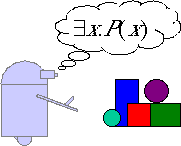 Learning Rich, Tractable Models of the
Real World
Learning Rich, Tractable Models of the
Real World
The everyday world of a household or a city street is exceedingly
complex and dynamic, from a robot's perspective. In order for robots
to operate effectively in such domains, they have to learn models of
how the world works and use them to predict the effects of their
actions. In traditional AI, such models were represented in
first-order logic and related languages; they had no representation of
the inherent uncertainty in the world and were not connected up to
real perceptual systems. More recent AI techniques allow
model-learning directly from perceptual data, but they are
representationally impoverished, lacking the ability to refer to
objects as such, or to make relational generalizations of the form:
"If object A is on object B, then if I move object B, object A will
probably move too."
We are engaged in building a robotic system with an arm and camera
(currently, in simulation) that will learn relational models of the
environment from perceptual data. The models will capture the
inherent uncertainty of the environment, and will support planning via
sampling and simulation.
Research Group
Research Notes
-
Learning Probabilistic Rules From Experience. Very informal draft. (Postscript).
-
Learning in Worlds with Objects, to appear in the AAAI Spring Symposium, March, 2001.
(Postscript).
Presentations
-
Research presentation at NTT-MIT Research Collaboration meeting,
Kyoto, Japan, January, 2001
(Powerpoint).
Reading Group
In Fall 1999, we conducted a reading group on the topic of higher
order representations in robotics. More details.
 Learning Rich, Tractable Models of the
Real World
Learning Rich, Tractable Models of the
Real World Learning Rich, Tractable Models of the
Real World
Learning Rich, Tractable Models of the
Real World